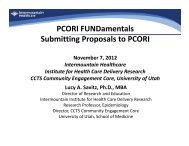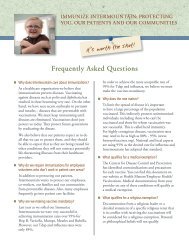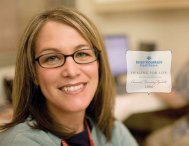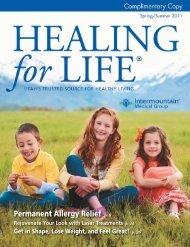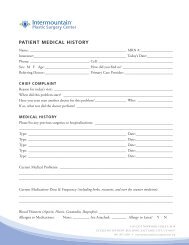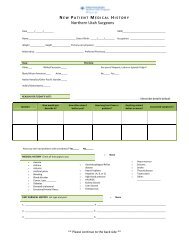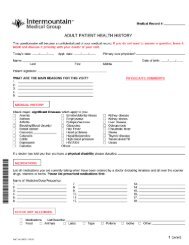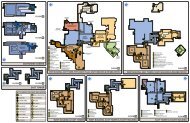Download the PDF - Intermountain Healthcare
Download the PDF - Intermountain Healthcare
Download the PDF - Intermountain Healthcare
You also want an ePaper? Increase the reach of your titles
YUMPU automatically turns print PDFs into web optimized ePapers that Google loves.
HFL2SEL11008_FallPrint_Hea<strong>the</strong>rAdams.indd 12/29/2012 1:09:05 PMselectsecurity“When my daughter was three, she developed a chronic illness. After ayear of tears every month, when we were covered by a different insurancecompany, it really taught me how great SelectHealth is. I was so delighted tochange back. At SelectHealth, <strong>the</strong>y do what <strong>the</strong>y say <strong>the</strong>y’re going to do.”Hea<strong>the</strong>r Adams, American Forkselec<strong>the</strong>alth.org© 2011 SelectHealth. All rights reserved. 1661 10/112 INTERMOUNTAIN MEDICAL GROUP <strong>Intermountain</strong>MedicalGroup.org <strong>Intermountain</strong>MedicalGroup.org 3
CombiningPhysical + behavioral<strong>Healthcare</strong> for ChildrenBudge Pediatrics: A pioneer for preventative pediatric careBy Clint Field, PhDA critical and much valued aspect of pediatric medicine is<strong>the</strong> emphasis placed on prevention. Prevention servicesbenefit children and families immediately as well as across<strong>the</strong>ir lifetime. However, <strong>the</strong> scope of prevention servicesneed not be limited to a child’s physical health. Recentchanges at <strong>Intermountain</strong> <strong>Healthcare</strong> have created <strong>the</strong>opportunity for preventative behavioral health services tobe made available to families. As an organization, <strong>Intermountain</strong>has made a commitment to <strong>the</strong> integration ofphysical and behavioral health services for patients withinprimary care clinics.Accordingly, <strong>the</strong> pediatric department at <strong>the</strong> BudgeClinic in Logan has adopted a cutting-edge model ofcare integrating physical and behavioral health servicesfor children. Pediatricians and behavioral-pediatricpsychologists are now a fully integrated team located in<strong>the</strong> same clinic space, with adjoining offices, and consultwith each o<strong>the</strong>r in person, multiple times daily. This is amodel of care that cannot be found elsewhere in CacheValley; only a few o<strong>the</strong>r such places around <strong>the</strong> countryare known to exist!Budge Pediatrics has taken <strong>the</strong> model a step fur<strong>the</strong>r bybecoming <strong>the</strong> first pediatric clinic in <strong>the</strong> country to offerpatients <strong>the</strong> opportunity to participate in a behavioralhealth universal prevention program for children. Thisservice is being offered without charge to interestedparents of 2-year old children. It has been designed toprovide every parent with <strong>the</strong> critical skills for managing<strong>the</strong> negative behaviors children display during <strong>the</strong>developmental period, often referred to as <strong>the</strong> “terribletwos.” This is significant for a few reasons. First, researchhas suggested this period should possibly be renamed “<strong>the</strong>terrible one-and-a-halves to threes.” Experienced parentsknow <strong>the</strong> challenging behaviors encountered can endurefor two to three years and are a significant source of stressfor families and negative strain on <strong>the</strong> parent-child relationship.Second, surveys of pediatricians have indicatedthat problems with tantrums and disobedience are someof <strong>the</strong> most frequent concerns shared by parents duringcheck-ups, suggesting that almost all parents encounter<strong>the</strong>se challenges and many are not sure how to respond.The origins of this novel and effective approach to preventioncan be traced to <strong>the</strong> behavioral pediatric researchgroup at Utah State University. Doctoral students from<strong>the</strong> University have partnered with pediatricians indelivering <strong>the</strong> service at <strong>the</strong> Budge Clinic. The preventionprogram is designed to keep typical problems fromgrowing out of parental control. Negative behaviors leftunaddressed during early childhood can translate intoa unnecessary risk that children will become aggressive,defiant, or experience academic problems. These behaviorsmay endure through middle school, even becoming asource of trouble during <strong>the</strong> teen years.Clint Field, PhDPediatric PsychologistBudge Clinic Pediatrics435.792.19406 INTERMOUNTAIN MEDICAL GROUP <strong>Intermountain</strong>MedicalGroup.org<strong>Intermountain</strong>MedicalGroup.org 7
Statistically speaking,heart disease is <strong>the</strong> most common cause of death among both men and women,claiming <strong>the</strong> lives of more than a half million Americans each year.Coronary artery disease results from <strong>the</strong> buildup of fat and cholesterolin <strong>the</strong> arteries that supply blood to <strong>the</strong> heart. These cholesterol ladendeposits are called a<strong>the</strong>rosclerotic plaques. A<strong>the</strong>rosclerosis is <strong>the</strong> medicalterm for “hardening of <strong>the</strong> arteries.” Current research shows that thiscondition can begin as early as adolescence.Statistically speaking, heart disease is <strong>the</strong> most common cause of deathamong both men and women, claiming <strong>the</strong> lives of more than a halfmillion Americans each year.As a<strong>the</strong>rosclerotic plaques grow, portions of <strong>the</strong> artery become cloggedand narrowed. If an artery is severely obstructed, it reduces blood flowto <strong>the</strong> heart causing chest pain due to lack of oxygen and nutrientdelivery to <strong>the</strong> pumping heart muscle. The heart beats all day, everyday, and requires tremendous blood supply. A heart attack (myocardialinfarction or MI) occurs when a coronary artery plaque ruptures andcompletely occludes blood flow to <strong>the</strong> working heart muscle. Withoutoxygen and nutrients, heart tissue is damaged or even dies. If you survive<strong>the</strong> attack, your heart can sustain damage that puts you at greaterrisk for future cardiac events and may limit your heart’s ability to supportyour former level of activity.Although many patients with severe coronary artery disease have noclear identifiable risk factors, <strong>the</strong> major obvious factors of <strong>the</strong> diseaseare: age, family history of heart disease, diabetes, tobacco, and elevatedcholesterol or blood pressure.Following a heart healthy lifestyle, risk factor modification, and earlydisease recognition are <strong>the</strong> key to preventing coronary artery disease.To determine if you have coronary artery disease and, if so, how severeit may be, visit your healthcare provider. Your clinician will assess yourlikelihood of coronary artery disease based upon your risk profile,examination, or possibly diagnostic testing.Gerald I. Polukoff, MDInterventional CardiologyCache Valley Heart Clinic435.716.2200By Gerald I. Polukoff, MDCommonWarning Signsof aHeart AttackChest DiscomfortFrequently, chest discomfort is located in <strong>the</strong> centerof <strong>the</strong> chest, lasts more than a few minutes, and maycome and go. It can present as uncomfortable pressure,squeezing, fullness, or pain. The discomfort is oftenassociated with sweating, nausea, shortness of breath,and a sense of panic.Not all peoplewithHeart Attackshave Chest Pain:Discomfort can occur in o<strong>the</strong>r areas of <strong>the</strong> upperbody including pain or an ache in one or both arms,back, neck, jaw, or stomach. You could also experienceunexplained shortness of breath with or without chestdiscomfort and/or light-headedness, fainting,or palpitations.Don’t Delay. Take action by calling 911and getting to <strong>the</strong> hospital as soon as possible.In a Heart Attack,every second counts.10 10 INTERMOUNTAIN MEDICAL GROUP <strong>Intermountain</strong>MedicalGroup.org<strong>Intermountain</strong>MedicalGroup.org 11
Hospitals are Helping MomsTake an Active Rolein <strong>the</strong>irChildbirth DecisionsAbout 4 million women in <strong>the</strong> United States,if recent trends hold true, will give birth this year.As her relationship begins with her new baby, eachwoman will have fun, exciting, and important decisionsto make: choosing her baby’s nursery accessories, herbaby’s name, and where to deliver her baby.Women have more birthing options now than ever before.Hospitals are still <strong>the</strong> number one choice for <strong>the</strong> vastmajority of women in <strong>the</strong> U.S., but <strong>the</strong> ageless motive tochoose a hospital birth over ano<strong>the</strong>r option simply because<strong>the</strong> hospital can “take care of me and my baby in an emergency”is not <strong>the</strong> only reason women are choosing hospitalbirths <strong>the</strong>se days.Hospitals are implementing patient-centered care approachesto more actively involve patients in <strong>the</strong>ir health care decisions.Patient-centered care is based upon open communicationbetween <strong>the</strong> provider, patient, and <strong>the</strong>ir familymembers. The approach involves <strong>the</strong> patient in all aspects of<strong>the</strong>ir care and empowers <strong>the</strong>m to seek <strong>the</strong> best solution formanagement or treatment of <strong>the</strong>ir health care need.Nationally, <strong>Intermountain</strong> Logan Regional Hospital isahead of <strong>the</strong> curve in <strong>the</strong> implementation of patientcenteredcare at its Women and Newborn Center. A newmom works with physicians as a team to have <strong>the</strong> birthingexperience she desires by:Taking an active role in making decisions about herchildbirth optionsHaving educated choices which may include medicatedor non-medicated birthing optionsCarrying out <strong>the</strong> instruction she learned in childbir<strong>the</strong>ducation classesWorking to progress labor with techniques thatfacilitate her comfort, relaxation, and <strong>the</strong> naturalphysiological changes to help her give birthTechniques can include: position changes and movement,massaging, hypnobirthing, hydro<strong>the</strong>rapy, andaroma<strong>the</strong>rapyConsulting with <strong>the</strong> well-trained nursing staff whoprovide her both instruction and emotional supportAt Logan Regional Hospital’s Women and Newborn Center,<strong>the</strong> execution of patient-centered care results in betteroutcomes for moms and babies, a lower risk of intervention,and ultimately, a unique and memorable childbir<strong>the</strong>xperience for every woman.14 14 INTERMOUNTAIN MEDICAL GROUP <strong>Intermountain</strong>MedicalGroup.org<strong>Intermountain</strong>MedicalGroup.org 15 15
Logan Regional is <strong>the</strong>Family Behind Your FamilyFinding qualityhome care doesn’thave to be diffi cult.We make home care easy.“ A fter my son Walker was born six weeks early,I stayed at Logan Regional Hospital for 20 days. The nurses and <strong>the</strong> staff tooksuch good care of us. I’ve had all five of my boys at Logan Regional.It’s our family hospital — <strong>the</strong> only place I’d ever want to go.”Erica Low, ProvidenceHOSPICEHOME HEALTHINFUSION THERAPY &SPECIALTY PHARMACYHOME MEDICAL EQUIPMENTCACHE VALLEYHome Health & Hospice(435) 716-5477Home Medical Equipment(435) 716-5396full service ad logan.indd 18/24/2011 4:15:45 PMVisit loganregional.org16 INTERMOUNTAIN MEDICAL GROUP <strong>Intermountain</strong>MedicalGroup.org <strong>Intermountain</strong>MedicalGroup.org 17
SustainableWeight LossBy Patrick Shepherd, R.D.Exercise and weight lossare often explained asfitting toge<strong>the</strong>r as a hand and glove model; in that,one without <strong>the</strong> o<strong>the</strong>r is thought to be ineffective.While this idea sounds credible, many who engagein consistent and aggressive physical activity oftenreport <strong>the</strong> opposite: weight gain. Such weight gainis frequently explained away as simply <strong>the</strong> neteffects of increasing muscle mass (a more densetissue) concurrent with <strong>the</strong>ir fat loss. This may notalways be <strong>the</strong> case.The body provides energy to sustain itself (breathing,pumping blood, repair, and activity) fromthree main sources: carbohydrates, fats, andproteins. While all three can be used as an energysource, not all energy pathways operate at <strong>the</strong> samespeed. In high intensity activity, <strong>the</strong> majority ofenergy is derived from carbohydrates with smallerquantities coming from fat and protein. Such activitydoes burn calories, but simply burning caloriesmay not ensure weight loss. Weight loss comesfrom sustaining a calorie deficit over time.It is common that when people begin a weight lossregimen <strong>the</strong>y may aggressively restrict <strong>the</strong>ir calorieintake via counting calories or simply reducing portionsizes. Initial days of restriction are overshadowedby <strong>the</strong> idea that “if moderation leaves me alittle hungry and only causes moderate weight loss,I might as well get it over with by being really hungry,and see faster weight loss.” This type of restrictionalone is enough to be NON-SUSTAINABLEin <strong>the</strong> long term.Compounding thisproblem is that many alsobegin an intense regimenof physical activity. At highintensities <strong>the</strong> calories beingburned come from <strong>the</strong>body’s reserve of carbohydrates,of which verylittle is stored, 1500-2500calories at all times. Thisintense burst of activityleaves <strong>the</strong> person carbohydratedepleted and feelingVERY HUNGRY, whichcauses <strong>the</strong> hunger response to prod <strong>the</strong>m towardsreplacing <strong>the</strong> carbohydrate calories expended.This may result in <strong>the</strong> person returning from<strong>the</strong>ir workout, consuming a small meal, and stillfinding <strong>the</strong>mselves starving afterwards. The bodycontinues to express its frustration until its lack ofcarbohydrate stores is replenished. Eventually aperson yields to <strong>the</strong>ir hunger with compensatoryeating which counterbalances or overbalances <strong>the</strong>calories <strong>the</strong>y burned during <strong>the</strong>ir workout, resultingin weight gain.A person desiring to lose weight and be physicallyactive should <strong>the</strong>refore engage in an exercise planthat is of a sustainable and of a moderate intensity.Even though moderate activity will not burn nearlyas many calories as intense activity, it can derive<strong>the</strong> majority of its energy from fat stores, (which iswhat most of us want to reduce in <strong>the</strong> first place)and leave <strong>the</strong> majority of <strong>the</strong> carbohydrate storesintact. This can allow a person to pursue physicalactivity without engendering a large spike in hungerlevels. Such a moderate attack combined with awell-constructed meal plan can allow <strong>the</strong> person toachieve meaningful weight loss and actuallyENJOY physical activity for <strong>the</strong> rest of <strong>the</strong>ir lives.Patrick Shepherd, RDDieticianBudge Clinic435.792.171020 INTERMOUNTAIN MEDICAL GROUP <strong>Intermountain</strong>MedicalGroup.org<strong>Intermountain</strong>MedicalGroup.org 21 21
understands healingisn’t always about giving you more time.Sometimes it’s about helping make <strong>the</strong>most out of <strong>the</strong> time you have left.Hospice can help.• Pain & Symptom Management• End-of-life planning• Nursing & Aide Services• Social Work & Spiritual Support• Caregiver Respite• Bereavement Services<strong>Intermountain</strong> Homecare is a full service home careprovider offering: Hospice, Home Health,Home Medical Equipment, andHome Infusion Therapy.For more information, call435-716-5477.hospice ad logan.indd 18/24/2011 4:17:50 PM22 INTERMOUNTAIN MEDICAL GROUP <strong>Intermountain</strong>MedicalGroup.org <strong>Intermountain</strong>MedicalGroup.org 23
HOW DO I CHOOSE ACOSMETICS U R G E O N ?By Casey N. Isom, MDIn today’s world we are barraged with advertisementspromising quick fixes to look and feel better.Patients are sometimes confused when it comes to choosinga qualified physician to provide cosmetic services.Many offer amazing results with little risk. It can be difficultto distinguish who is a legitimate surgeon and whois not, especially when you see an MD behind <strong>the</strong> person’sname. I would like to recommend ways to maximize yourchances of success with a cosmetic procedure and minimizeyour risk of complications and disappointment.There is an alarming trend where healthcare workers andeven doctors are practicing medicine far beyond <strong>the</strong>ir scopeof training. Examples of this are medical spas and so calledmedical institutes that are operated by nurses or familydoctors who have no formal training in plastic or any kindof surgery. Some limit <strong>the</strong>mselves to Botox, filler injectionsand spa type treatments that are relatively benign. O<strong>the</strong>rs,however, perform invasive procedures such as laser peels, fatgrafting and liposuction in an office setting with no formaltraining. Unfortunately, a surgical instrument in <strong>the</strong> handsof an untrained physician can become a deadly weapon.These doctors typically do not have privileges at <strong>the</strong>ir localhospital which requires that <strong>the</strong>y practice within <strong>the</strong> limitsof <strong>the</strong>ir training. If <strong>the</strong> patient ends up with a complication,<strong>the</strong>y are told to make <strong>the</strong>ir way to <strong>the</strong> nearest emergencyroom because <strong>the</strong> doctor is unable to take care of <strong>the</strong> complication.Dissatisfaction and complication rates are usuallyhigh when untrained doctors dabble outside of <strong>the</strong>ir medicalspecialty in search of higher income. It is interesting tonote <strong>the</strong>se clinics advertise more than reputable surgeonsbecause <strong>the</strong>y cannot rely on referrals from satisfied patients.They offer bargain prices, but in reality <strong>the</strong>ir fees are notmuch less than those done by a qualified board certifiedplastic surgeon. The old adage that you get what you payfor is true in this case. Besides, <strong>the</strong> cost of a complicationor disfiguring result can be very high indeed. I feel stronglythat if a family physician desires to practice plastic surgery,<strong>the</strong>y should complete a residency in plastic surgery, ra<strong>the</strong>rthan attend a weekend course and think <strong>the</strong>y can do whattypically takes six years to master.Medical training in <strong>the</strong> United States begins with fouryears of medical school where students learn a little bitabout all <strong>the</strong> major medical specialties. After which <strong>the</strong> titleof medical doctor is bestowed: if <strong>the</strong> licensing exams arepassed. The next step is to apply for residency training in<strong>the</strong> budding doctor’s chosen field. Some specialties are particularlycompetitive and require excellent exam scores andclinical performance in order to be accepted. An exceptionallyqualified new doctor will likely be accepted into <strong>the</strong>irchosen specialty. If not, <strong>the</strong>y may end up training in a lesscompetitive specialty. After residency training, <strong>the</strong> new physiciancan legally practice any type of medicine <strong>the</strong>y desirewithin <strong>the</strong>ir private clinic. However just because somethingis legal doesn’t mean it is ethical or safe, nor covered by <strong>the</strong>irmalpractice liability insurance. In order to work within<strong>the</strong> hospital system one must be credentialed by a panelof physicians and hospital representatives who ensure <strong>the</strong>clinician has been properly trained and is practicing within<strong>the</strong> limits of <strong>the</strong>ir training. Be wary of surgeons without ahospital affiliation.Many surgeons claim board certification. The question hasto be asked, “Board certified in what and by whom?” In<strong>the</strong> United States <strong>the</strong> American Board of medical specialties(ABMS) is a not-for-profit body which oversees 24approved medical specialty boards. They are instrumentalin <strong>the</strong> development and use of standards in <strong>the</strong> ongoingevaluation and certification of physicians. ABMS isrecognized as <strong>the</strong> gold standard in physician certification.The American Board of Plastic Surgery is <strong>the</strong> only plasticsurgery board recognized by <strong>the</strong> ABMS. Certification by<strong>the</strong> American Board of Plastic Surgery guarantees that yoursurgeon has completed an accredited residency program inplastic surgery. Vigorous testing by leaders in <strong>the</strong> field ofplastic surgery assures <strong>the</strong> individual has been recognized asa safe, ethical, and competent surgeon. This is an ongoingprocess requiring periodic recertification exams, continuingmedical education and review of surgical results. Certainspecialties cross-over into <strong>the</strong> realm of plastic, reconstructiveand even cosmetic surgery depending on <strong>the</strong>ir area of expertise.Examples of <strong>the</strong>se are ear, nose and throat surgeons,dermatologic surgeons, and oculoplastic surgeons who dealwith surgery of <strong>the</strong> eye.A news report was recently broadcast by KSLnews on this very issue. It can be found athttp://www.ksl.com/?nid=148&sid=155703496.Some important questions to askany healthcare provider beforeallowing <strong>the</strong>m to perform an invasivecosmetic procedure would be:What and where was your specialty training?What is your board certification specialty?Do you have hospital privileges and where?What are <strong>the</strong> possible complications and how would<strong>the</strong>se be dealt with?Are you operating in a certified operating room, andwhich organization has provided <strong>the</strong> certification?(A certified operating room is has met standards ofsafety and is equipped to handle life-threateningcomplications a patient may experience during asurgical procedure)Can you show me examples of average results?Can I speak with some of your previous patients?If <strong>the</strong> answers to <strong>the</strong>se questions are not satisfactory or ifyou feel uncomfortable, I would recommend seeking asecond opinion by a surgeon certified by <strong>the</strong> AmericanBoard of Plastic Surgery. Every doctor in this countrytook an oath to do no harm. Practicing medicine beyond<strong>the</strong> limits of <strong>the</strong>ir specialty violates this oath.Casey N. Isom, MDIsom Plastic Surgery435.792.176024 INTERMOUNTAIN MEDICAL GROUP <strong>Intermountain</strong>MedicalGroup.org<strong>Intermountain</strong>MedicalGroup.org 25
30 INTERMOUNTAIN MEDICAL GROUP <strong>Intermountain</strong>MedicalGroup.org <strong>Intermountain</strong>MedicalGroup.org 31
TrampolineIncontinence... What is it?So why is it that many moms refuseto jump on trampolines? Really, it is a child’sdream to have mom share in <strong>the</strong> excitement, right? Althoughthis could be due to many reasons, we tend to believe lotsof women hesitate due to urinary incontinence. It is a verycommon ailment we see on a daily basis in our community aswell as world-wide. Leaking while on <strong>the</strong> trampoline is no real“accident.” Ra<strong>the</strong>r, it is a combination of several important andundeniable factors all present in our society today.The first factor is <strong>the</strong> physical position of <strong>the</strong> female bladderwithin <strong>the</strong> pelvis with a very short urethra as well as <strong>the</strong> externalforces present with weight gain. Second, <strong>the</strong> incrediblegravitational forces present when decelerating so quickly whilejumping. And third, it deals with <strong>the</strong> laxity of <strong>the</strong> pelvic floorthat comes from childbearing and age. Although a very commonailment world-wide, this seems to be even more so locally due to<strong>the</strong> prevalence of each of <strong>the</strong>se factors present in our communitytoday. One has to believe that we are contenders for trampolinesper capita, as well as a leader when it comes to size of family, asincreased vaginal birth certainly has great potential to weaken<strong>the</strong> pelvic floor which contributes to <strong>the</strong> leaking.By Teryl Hunsaker, PA-C and Kristin Craig, MDWhat is urinary incontinence (UI)?Urinary incontinence is <strong>the</strong> loss of urine control, or <strong>the</strong> inabilityto hold your urine until you can reach a restroom. Accordingto <strong>the</strong> National Association for Continence, approximately25 million adult Americans experience temporary or chronicurinary incontinence. UI can strike at any age. Women overage 50 are <strong>the</strong> most likely to develop UI and typically increasesin prevalence as one ages. Urinary incontinence may be a temporarycondition resulting from an underlying medical condition.It can range from <strong>the</strong> discomfort of slight losses of urineto severe, frequent wetting.What causes urinary incontinence?Incontinence is not an inevitable result of aging, but is particularlycommon in older people. It is often caused by specificchanges in body function that may result from diseases, use ofmedications, and/or <strong>the</strong> onset of an illness. Sometimes it is <strong>the</strong>first and only symptom of a urinary tract infection. Women aremost likely to develop incontinence ei<strong>the</strong>r during pregnancyand childbirth, or after <strong>the</strong> hormonal changes of menopause,because of weakened pelvic muscles.What are some of <strong>the</strong> different types ofurinary incontinence?The following are <strong>the</strong> most common forms of urinary incontinence:• Urge incontinence — <strong>the</strong> inability to hold urine long enoughto reach a restroom. This is often accompanied by urinary frequency.It is common in people who have conditions such asdiabetes, stroke, dementia, Parkinson’s disease, and multiplesclerosis, but may be an indication of o<strong>the</strong>r diseases or conditionsthat would also warrant medical attention.• Stress incontinence — <strong>the</strong> most common type of incontinencethat involves <strong>the</strong> leakage of urine during exercise,coughing, sneezing, laughing, lifting heavy objects, or o<strong>the</strong>rbody movements that put pressure on <strong>the</strong> bladder. (i.e.jumping on trampolines)What are <strong>the</strong> symptoms of urinaryincontinence that indicate that youshould get treatment?The following are <strong>the</strong> most common indications of urinary incontinence.However, each individual may experience symptomsdifferently:• Progressive weakness of <strong>the</strong> urinary stream with or without afeeling of incomplete bladder emptying• An increased rate of urination (frequency) without a provenbladder infection• Needing to rush to <strong>the</strong> restroom and/or losing urine if youdo not get <strong>the</strong>re in time• Leakage of urine that prevents activities• Leakage of urine that began or continued after surgery• Leakage of urine that causes embarrassment• Frequent bladder infectionsThe symptoms of urinary incontinence may resemble o<strong>the</strong>rconditions or medical problems. Always consult your physicianfor a diagnosis.How is urinary incontinence diagnosed?For people with urinary incontinence, it is important to consulta physician for a complete physical examination that focuses on<strong>the</strong> urinary and nervous systems, reproductive organs, and urinesamples. In many cases, patients will <strong>the</strong>n be referred to a urologist,gynecologist, or a urogynecologist. All are physicians whospecialize in diseases of <strong>the</strong> urinary tract.Teryl Hunsaker, PA-CBudge Urology Specialists435.792.1950Kristin Craig, MDBudge OB/GYN Specialists435.716.1920Treatment for urinary incontinence:Only in cases of frequent bladder infections would UI causeo<strong>the</strong>r medical problems. The decision for treatment, <strong>the</strong>refore,is based on how <strong>the</strong> symptoms affect your lifestyle. If you aregiving up activities, travel etc., or if you are wearing a pad daily,it is worth it to consider treatment.Specific treatment for urinary incontinence will be determinedby your physician based on:• The type of incontinence you have• Your age, overall health, and medical history• Extent of <strong>the</strong> problem• Your tolerance for specific medications, procedures, or <strong>the</strong>rapies• Urodynamic studies performed in a special bladder lab toproperly assess <strong>the</strong> cause of incontinence and to determine<strong>the</strong> best treatment options.In general, stress incontinence is treated with anatomic changessuch as exercises and surgery. Urge incontinence is treated withphysiologic changes such as behavior modification and medications.Treatment may include:Behavioral <strong>the</strong>rapies (to help people regain control of <strong>the</strong>ir bladder),including <strong>the</strong> following:• Bladder training teaches people to resist <strong>the</strong> urge to void andgradually expand <strong>the</strong> intervals between voiding.• Toileting assistance uses routine or scheduled toileting,habit training schedules, and prompted voiding toempty <strong>the</strong> bladder regularly to prevent leaking.• Dietary Modifications avoidance of caffeine, citrus,chocolate, coffee, carbonation, or spicy foods. Thesefoods provide a significant irritation to <strong>the</strong> bladder.• Pelvic muscle rehabilitation (to improve pelvic muscle toneand prevent leakage), including <strong>the</strong> following:• Kegel exercises/Biofeedback/Pelvic Floor Stimulation• Regular, daily exercising of pelvic muscles can improve,and even prevent, urinary incontinence. This is particularlyhelpful for younger women. Should be performed30-80 times daily for at least eight weeks. Awareness of<strong>the</strong>se muscles and specific intervention is carried out bya physical <strong>the</strong>rapist who specializes in this.• Medication (including specific drugs for incontinence aswell as estrogen <strong>the</strong>rapy, which may be helpful in conjunctionwith o<strong>the</strong>r treatments for postmenopausal women withUI). The popular anticholinergics medications are oftenprescribed and include medications like Detrol, Vesicare,Toviaz, Ditropan.• Surgery (if <strong>the</strong> incontinence is related to structural problemssuch as an abnormally positioned bladder or a blockage).this includes bladder suspensions and sling procedures. Thefemale mid urethral sling has truly revolutionized <strong>the</strong> treatment—minimallyinvasive with great success rates in a wellselected population.32 INTERMOUNTAIN MEDICAL GROUP <strong>Intermountain</strong>MedicalGroup.org <strong>Intermountain</strong>MedicalGroup.org 33 33
Treat it!Gout:By Corey W. Walker, MDWhat is Gout?Gout is a type of inflammatoryarthritis caused by <strong>the</strong> deposition of uric acid crystalsin <strong>the</strong> joints and o<strong>the</strong>r tissues. Excess uric acid occursbecause of overproduction in some individuals or aninability to excrete it out of <strong>the</strong> body through <strong>the</strong>kidneys. It affects approximately three percent of <strong>the</strong>population and men more than women.Gout generally starts withintermittentattacks of inflammation in <strong>the</strong> toes causing severe pain,swelling, and usually redness to <strong>the</strong> joint involved. Theattacks usually come and go for awhile, <strong>the</strong> personbeing asymptomatic between flare ups. Over time andwithout treatment <strong>the</strong> gout attacks start increasing inseverity and frequency. Eventually it can start attackingo<strong>the</strong>r joints like <strong>the</strong> ankles, knees, wrists, elbows, andsometimes fingers. Left untreated it can cause persistentinflammation in <strong>the</strong> joints and, more importantly,permanent damage to <strong>the</strong> joints involved.Factors that increasea person’s chances ofhaving a gout attack include certain medications (diureticsand low dose aspirin) and foods that are highin purines (red meats, shell fish, alcohol, soft drinks,and fructose). Foods that can decrease gout attacks aredairy products and vitamin C.Gout is diagnosedby finding evidence of toomuch uric acid in <strong>the</strong> body, usually through a bloodtest and identifying uric acid crystals in <strong>the</strong> joint fluid.Treatment of gout is broken down into two differentgoals: treatment of <strong>the</strong> inflamed, painful, and swollenjoint(s), and second, treatment of <strong>the</strong> underlyingproblem which is high uric acid in <strong>the</strong> body.Acute AttacksThe goal of treatment here is to startmedication as soon as symptoms appear tocontrol pain and minimize <strong>the</strong> severity of<strong>the</strong> attack. Nonsteroidal anti-inflammatorydrugs (NSAIDs) are typically first line<strong>the</strong>rapy. Ibuprofen 800mg three times dailyor indomethacin 50mg three times daily arecommonly used. Colchicine (Colcrys) hasbeen around since <strong>the</strong> beginning of timeand also is commonly used to control anacute flare of <strong>the</strong> disease. Glucocorticoids, aclass of medications known as steroids, likeprednisone and joint injection of cortisone,are also used in more severe or difficult tocontrol flares of gout.Uric Acid LoweringTherapyThe most critical part of treating gout is getting<strong>the</strong> uric acid level down in <strong>the</strong> body toprevent recurrences of gout attacks and jointdamage. Medications used for this includeallopurinol, febuxostat (Uloric), probenacid,and pegloticase (Krystexxa). Also, changingones diet to take in less red meats, shellfish,and alcohol is important. This typically involveslong term commitment to treatmentbut is well worth it in <strong>the</strong> end.Corey Walker, MDRheumatologyBudge Clinic435.792.151834 INTERMOUNTAIN MEDICAL GROUP <strong>Intermountain</strong>MedicalGroup.org<strong>Intermountain</strong>MedicalGroup.org 35 35
PAID ADVERTISEMENTThe Anatomyof <strong>the</strong> EyeIrisPAID ADVERTISEMENTOptic NervePupilCorneaRetinaLensG l a u c o m aT h e P r e v e n t a b l e B l i n d n e s sThe inside back of <strong>the</strong> eyeballis lined by cells that detect light(<strong>the</strong> retina cells). All <strong>the</strong>se cells are associatedwith nerve fibers which coalesce and exit <strong>the</strong> backof <strong>the</strong> eye to form a cable extending from <strong>the</strong>eye to <strong>the</strong> brain. This cable is known as <strong>the</strong> opticnerve. Glaucoma refers to a group of eye conditionswhich lead to characteristic damage of <strong>the</strong>optic nerve and is one of <strong>the</strong> leading causes ofpreventable blindness in <strong>the</strong> United States.In most cases, damage to <strong>the</strong> optic nerve comesfrom increased pressure inside <strong>the</strong> eye, alsoBy Christian D. Nilson, MDknown as intraocular pressure (IOP). If damageto <strong>the</strong> optic nerve goes undetected, it can eventuallylead to permanent blindness.There are four major types ofglaucoma:1. Open Angle (Chronic) Glaucoma2. Angle Closure (Acute) Glaucoma3. Congenital Glaucoma4. Secondary GlaucomaNormal Fundusand Optic NerveGlaucoma Damageto Optic NerveOpen Angle Glaucoma and Secondary Glaucoma patientsusually have no symptoms. Once <strong>the</strong> vision loss is apparent,<strong>the</strong> damage is very severe. In Acute Angle Closure Glaucoma,patients will have sudden severe pain in or around <strong>the</strong> eye, redness,decreased or cloudy vision, nausea, vomiting and halosaround lights. In Congenital Glaucoma, <strong>the</strong> child is usuallynoted to have cloudiness to <strong>the</strong> front of <strong>the</strong> eye, redness, enlargementof one or both eyes, tearing and sensitivity to light.A complete detailed eye exam is needed to evaluate <strong>the</strong> condition.If glaucoma is suspected, your eye doctor will do o<strong>the</strong>rtests to confirm <strong>the</strong> diagnosis.There is no cure for glaucoma but <strong>the</strong>reis treatment. The management depends on <strong>the</strong> type ofglaucoma. Acute Angle Closure Glaucoma usually requiresemergent treatment with medication (eye drops or oral pills)and can sometimes require urgent laser treatment. Treatmentfor more chronic glaucoma usually involves eye drops.Sometimes, patients need more than one type of drop. O<strong>the</strong>rtreatments can involve laser and/or surgery. Treatment, inmost cases, can halt <strong>the</strong> progression of <strong>the</strong> disease and preventfur<strong>the</strong>r optic nerve damage.Glaucoma is more common in patients over 40 years old andin patients with a family history of <strong>the</strong> disease. All adultsshould have a complete, detailed, dilated eye exam by age 40,or sooner, if you have risk factors for glaucoma or o<strong>the</strong>r eyeproblems.Christian D. Nilson, M.D.OphthalmologistNor<strong>the</strong>rn Utah Eye Center435.752.2020www.Nor<strong>the</strong>rnUtahEyeCenter.com36 INTERMOUNTAIN MEDICAL GROUP <strong>Intermountain</strong>MedicalGroup.org <strong>Intermountain</strong>MedicalGroup.org 37
Introducing Three Of Our Newest Physicians<strong>Intermountain</strong> Medical Group of Cache ValleyDr. Steven NailLogan Regional Wound and HyperbaricCenter and <strong>the</strong> <strong>Intermountain</strong> MedicalGroup welcome Steven Nail, MD, boardcertifiedwound and hyperbaric specialist.Dr. Nail brings seven years of wound-careexperience to his new role. He comesto Logan from Austin, Texas, where heserved as Assistant Medical Director atHyperbaric Physician Consultants. Healso has more than two decades of experiencein emergency medicine.A Texas native, Dr. Nail earned his bachelor’sdegree from Texas A&M Universityand attended medical school at Universityof Texas Health Science Center atSan Antonio. He completed a familypractice residency in Fort Worth, Texas,and is board certified in family practice,emergency medicine, and hyperbaricmedicine. Dr. Nail and his wife, Tatia,have five children and three grandchildren.They are pleased to join <strong>the</strong> CacheValley Community.Dr. Nail works with podiatrist CurtisPedersen, DPM, in treating patients at<strong>the</strong> Wound and Hyperbaric Center. Dr.Pedersen was one of <strong>the</strong> founding physicianswhen <strong>the</strong> Logan Wound Center firstopened in 2002. He is board certified infoot surgery and has 15 years of woundcareexperience.Dr. Gerald I. PolukoffDr. Gerald Polukoff joins <strong>the</strong> staff at<strong>Intermountain</strong> <strong>Healthcare</strong>’s Cache ValleyHeart Clinic from Salt Lake City,Utah, where he most recently worked ina private practice cardiology office. Hejoins <strong>Intermountain</strong> with exceptionalknowledge and experience in <strong>the</strong> field ofinterventional cardiology. His past workexperience includes Sorensen CardiovascularGroup (Salt Lake City), The HeartCenter (SLC), and <strong>the</strong> Heart Clinic ofCorpus Christi (Corpus Christi, Texas).He also served as an adjunct associateprofessor at <strong>the</strong> University of UtahSchool of Medicine.Dr. Polukoff specializes in interventionalcardiology. He attended <strong>the</strong> Universityof Florida for his undergraduate workand went on to <strong>the</strong> American Universityof <strong>the</strong> Caribbean where he received hismedical degree. He has completed his internshipand residency in internal medicineat <strong>the</strong> St. Louis University AffiliateTeaching Hospital in St. Louis, Missouriand has completed two fellowships – onein cardiovascular disease at <strong>the</strong> Universityof Texas Medical Branch and <strong>the</strong> o<strong>the</strong>r ininterventional cardiology at <strong>the</strong> Universityof Utah School of Medicine.Dr. Erica SmithJoining <strong>the</strong> Budge Clinic Obstetrics andGynecology, Erica Smith, MD, receivedher undergraduate and medical degreesfrom Marshall University in Huntington,West Virginia. Following <strong>the</strong> completionof her 48-month residency at East TennesseeState University in Johnson City,Tennessee, Dr. Smith joins <strong>Intermountain</strong>Medical Group July 2012.Dr. Smith is a member of <strong>the</strong> AmericanCollege of Obstetrics and Gynecology,<strong>the</strong> American Physicians Obstetrics andGynecology, <strong>the</strong> American Society of ReproductiveMedicine, and <strong>the</strong> AmericanMedical Woman’s Association.While she practices obstetrics and gynecologyfor all ages, she has a particularemphasis in pelvic ultrasound and adolescentgynecology.Dr. Smith was raised in rural WestVirginia. She and her husband, Mat<strong>the</strong>w,enjoy fly fishing, hiking, and naturephotography. They are delighted to join<strong>the</strong> Cache Valley community and lookforward to taking advantage of <strong>the</strong> valleyand all it has to offer.ALLERGY1350 N. 500 E., Logan435.792.1950AUDIOLOGIST1350 N. 500 E., LoganCobabe, Andrew, AuD435.792.1950CARDIOLOGY1300 N. 500 E., Suite 320, LoganOtrusinik, Rudolf, MDSaul, William L., MD435.716-2200DERMATOLOGY1350 N. 500 E., LoganHanson, Nathan W., MD435.792.1770DIETITIAN1350 N. 500 E., LoganShepherd, Patrick, RD435.792.1710ENT/OTOLARYNGOLOGY1350 N. 500 E., LoganStahl, Kathleen M., FNP435.792-1950FAMILY MEDICINE*Includes ObstetricsAvery, D. Barton, MD*Harris, Gary L., MD*435.563.3222190 S. Hwy. 165, ProvidenceBroadhurst, Jeremy W., DO*Call, Nathan H., MDFirth, R. Mark, MD*435.755.3300412 N. 200 E., LoganCarlson, Brian W., MD*Goates, Brad M., MDHyldahl, Douglas R., MD*435.713.2800GASTROENTEROLOGY1300 N. 500 E., Ste. 340, LoganGarg, Vikram, MD435.716.5900INTERNAL MEDICINE1350 N. 500 E., LoganFaux, David S., MD435.792.1806Francis, Michael R., DO435.792.1780435.792.1810Nash, Robert M., MD435.792.1805INTERNAL MEDICINE - CONT.Stones, Michael J., MD435.792.1807Strong, Jeffrey S., MD435.792.1808Szpunar, Agnes M., MD435.792.1804NEUROLOGY1350 N. 500 E., LoganWilliams, Michael H., MD435.792.1809OBSTETRICS/GYNECOLOGY500 E. 1400 N., LoganAnderson, Jennifer, NPBenedict, James P., MDCraig, Kristin F., MDFlansburg, Deborah, CNMHorsley, E. Brett, DOMcCulloch, Kimberly D., MDMurillo, Ena, NPOlsen, Tandy G., MD435.716.1920ORTHOPEDICS1300 N. 500 E., Ste. 130, LoganHooley, Eric W., MDKing, Bryan C., MDMurray, David P., MDHunt, Scott, PAStowers, Benjamin, PA435.716.2800PEDIATRICS1350 N. 500 E., LoganBrown, Nordell T., MDClarke, Derrel W., MDField, Clint E., PhDGarg, Prafulla D., MDHorkley, Tyson S., MDO’Dell, J. Dennis, MDRoper, Sheryl, PNPSchneider, Stephen D., MDVisick, Michael K., MD435.792.1940PHARMACIES412 N. 200 E., Logan435.713.27701350 N. 500 E., Logan435.792.1521PHYSICAL MEDICINE1300 N. 500 E., Ste. 130, LoganEgbert, Jacob R., DOPeterson, Cameron G., MD435.716.2800PLASTIC SURGERY1350 N. 500 E., LoganIsom, Casey N., MD435.792.1760PODIATRY1300 N. 500 E., Ste. 130, LoganPedersen, Curtis C., DPM435.716.2800RHEUMATOLOGY1350 N. 500 E., LoganWalker, Corey W., MD435.792.1518SPORTS MEDICINE1300 N. 500 E., Ste. 130, LoganLyons, Trek D., MD435.716.2800SURGERY1350 N. 500 E., LoganAnderson, Allan D., MDHarker, David L., MDWeiss, Bartley M., MD435.792.1950UROLOGY1350 N. 500 E., LoganCallister, Michael S., MDHunsaker, Teryl, PAPitcher, Brent, PA435.792.1950WORKMED412 N. 200 E., Logan435.713.2850WOUND CARE1300 N. 500 E., Ste. 130, LoganAnderson, Allan D., MDHarker, David L., MDNail, Steven, MDPedersen, Curtis C., DPMWeiss, Bartley M., MD435.716.2850URGENT CARE<strong>Intermountain</strong> InstaCare8 am-8 pm, seven days a week412 N. 200 E., Logan435.713.2710We’ve got adocfor that.38 INTERMOUNTAIN MEDICAL GROUP <strong>Intermountain</strong>MedicalGroup.org <strong>Intermountain</strong>MedicalGroup.org 39
INSTACARE8 A.M. TO 8 P.M.SEVEN DAYS A WEEK412 N 200 E435-713-2710• Prompt physician care for illness & injury• No appointment necessary• X-ray, lab, and pharmacy on-site• Most insurance plans accepted• Open most holidays





